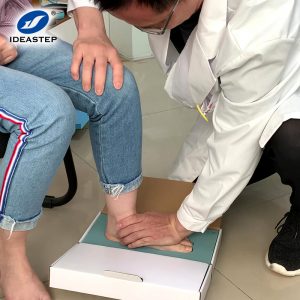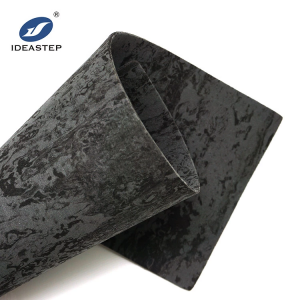Process Flow — Design and Production of Orthotic Insoles
The following focuses on the design and manufacturing methods of custom-made and custom-molded orthotic insoles (referred to as orthotic insoles).
1. Preliminary Preparation
1.1 Determine the Underlying Cause
The successful design and manufacture of orthotic insoles are related to doctors’ experience in treating foot problems. Thorough biomechanical examination of the foot and gait observation are important ways to determine the underlying cause.
A professional doctor should evaluate the position of the first metatarsophalangeal joint and ankle joint, the height of the arch, and the varus or varus of the hindfoot. Once the cause is determined, the doctor must determine the treatment goals, such as reducing pain, redistributing plantar pressure, improving the patient’s foot function, alleviating or preventing the further development of the disease, and providing guidance for the production of orthotic insoles and the selection of materials. Specifically include the following inspections.
1.2 Overall Posture Check
The overall posture examination needs to check the front and side when standing, the height of both shoulders, the height of the pelvis on both sides, the degree of inclination of the side of the pelvis, the appearance of the cervical spine to the lumbar spine, the foot length examination and prone and prone posture examinations.
1.3 Foot Biomechanics Inspection
Foot biomechanics examination includes foot appearance (plantar shape, bone arrangement, joint appearance, toe and ankle joint range of motion and plantar pressure examination, etc.).
1. 4 Gait Observation and Analysis
Gait is a behavioral characteristic of human walking, and normal walking involves the coordination and cooperation of multiple systems. The bones, nerves, and muscular system have lesions, which can easily manifest as abnormal gait. Therefore, gait observation and analysis are of great significance in the clinical diagnosis and evaluation of bone, nerve, and muscular system diseases.
Gait analysis and observation is a method to study walking rules and an important part of the evaluation of lower limb function. Its purpose is to clarify the mechanism and causes of abnormal gait, obtain quantitative gait data, select the optimal treatment strategy, and evaluate the rehabilitation efficacy.
Gait observation and analysis can be qualitative analysis and quantitative analysis.
(1) Qualitative analysis
Qualitative analysis is to observe the movement of the joints, muscles, and pelvis and the coordination of the posture from the front, back, and side of the patient through visual observation during walking.
(2) Quantitative analysis
Quantitative analysis is a quantitative inspection and analysis method that intuitively describes the movement of limbs during walking, and provides some effective ways for clinical evaluation of the functional status of lower limbs.

1.5 Get Foot Shape
Capturing the shape of the patient’s foot is very important for the production of orthotic insoles. Under normal circumstances, the foot model can be obtained with plaster, glass stockings, foam blocks, or paraffin wax.
The correct positioning of the foot, such as the determination of the neutral position of the subtalar joint, is very necessary for making an accurate foot model. Any deviation of this positioning will affect the quality and effect of the foot model.
1.5.1 Traditional Method
(1) Foot type data collection
Before making a foot model, you need to collect foot shape data. Commonly used methods are the footprint method and the foot photography evaluation method.
The information obtained by the footprint method is mainly the shape of the sole and the pressure distribution. The disadvantage is that it is impossible to know the arrangement of the bones, the relationship between the front and rear feet, and the way of bone compensation, and the accuracy is insufficient and the test process is cumbersome.
The advantages of the foot photography evaluation method are quick positioning, drawing lines, and taking pictures at the same time, shortening the test time. Not only is it convenient for subjects to check their foot problems, but it also helps doctors save the files on the computer as a reference for comparison before and after treatment, research statistics, and disease discussion.
(2) Foot model making
Plaster model casting is the most common method of making foot models. The patient was in a sitting position, with legs stretched out, and medical gauze soaked in plaster water was wrapped on the surface of the foot. Before the plaster is dry, gently push the 4th and 5th metatarsal heads to make the subtalar joint in a neutral position, and this neutral position must be maintained until the plaster hardens. Then take out the female mold left on the foot and make appropriate modifications.
In practice, bio-foaming materials can also be used to make foot models, which are clean and less time-consuming. The patient is also sitting, the thighs are parallel to the ground, the knee joints are bent at a 90° angle, and the lower legs are perpendicular to the ground. Gently place the patient’s foot in the center of the foam. The clinician stabilizes the patient’s ankle and slowly pushes down on the patient’s knee to force the foot into the foam. Apply extra force on the toes of the foot to press the heel, forefoot, and toes to the same depth, and then carefully lift the foot from the foam to create a female mold.
Regardless of the casting method, the male mold is immediately filled with plaster. After the plaster is hardened, it can be modified according to the doctor’s prescription to smooth or remove the protrusions or depressions on the plaster to provide the original shape of the sole of the hand-processed orthopedic insole.

1.5.2 Digital Method
Because the contours of the human ankle are very complicated, a high-precision three-dimensional scanner can scan and store the shape of the foot.
3D stereo scanning technology is a new technology that has been developed in the past 20 years. The stereo scanner can save the curved shape of the foot, which can be used for scientific research, assist doctors in clinical diagnosis, compare patients before and after treatment, and let patients understand the condition in time.
Orthopedics can tailor-made orthotic insoles based on the scanned foot shape data, with insole design software and CAM equipment.
Figure 1 shows the iQube 3D (British Delcam Company) laser scanner, which is powerful, easy to use, accurate and efficient, and reliable in performance. It can be used in orthopedic insole design, medical treatment, and other fields. It can support full-weight, semi-weight-bearing, or non-weight-bearing plantar scans.

Fig. 1 iQube 3D scanner
Figure 2 shows the Techmed 3D (Canada TechMed 3D Company) handheld scanner, which is mainly used to assess various foot diseases and retain 3D image data of the foot shape for custom shoe and insole design.

Fig. 2 Techmed 3D scanner
2. Insole Material Selection
Orthotic insoles can be selected from a wide range of materials. Many materials or combinations of materials can meet the performance requirements of orthotic insoles, such as density, hardness, durability, flexural resistance, abrasion resistance, elasticity, reaction temperature, and stiffness, etc. . Commonly used materials include polyethylene foam, ethylene-vinyl acetate (EVA), leather, cork, etc.
According to different hardness, these materials can be divided into hard type, semi-hard type, and soft type. The specific selection depends on the inspection results and the purpose of treatment. For rigid bone deformation, the main purpose of treatment is to adjust, soft materials should be selected, and the main functions are to reduce shearing forces, disperse pressure, and relieve pain.
For bones that still maintain a fairly soft deformation, the main purpose of treatment is to correct the function. Hard or semi-rigid materials should be selected to control abnormal foot movements. However, in the production process, if a small error occurs, it is easy to cause iatrogenic injury. The more severe the deformation, the less able to accept hard insoles. Therefore, these patients can consider wearing softer insoles first, and then change to hard insoles after adapting. Most of the newly developed insoles tend to be made of two or more materials with different densities while taking into account the functions of correction and decompression.

3. Insole Modeling and Processing
For custom-molded orthotic insoles, the traditional method is to heat the thermoplastic material and put it on the plaster male mold of the foot, and then set the shape by vacuum equipment. However, this method of making insoles is not precise enough, and the manufacturing process takes a long time.
At present, the design of orthotic insoles can be completed through professional software. More mature professional insole design and processing software, such as the Orthomodel & Orthomill orthopedic insole design and processing system of Delcam in the United Kingdom and the insole CAD design and processing system of Medicaid in Germany. At the same time, general 3D design software (such as rhino) can also be used for insole design. When designing, the foot shape data obtained by the three-dimensional scanner is imported into the software, and the insole is modeled according to different foot diseases.
In the design of insole modeling, the advantage of professional software is that the rendering effect is good. In the process of designing the structure line, the foot shape can be observed, and it can automatically generate a more suitable insole shape according to the complex surface of the foot. Convenient for design and editing. The disadvantage lies in the high requirements for computer hardware. The advantage of universal design software (such as rhino) is that the editing of lines and the capture of key points are very smooth and convenient, and it takes up less space in computer memory. The disadvantage is that the modeling steps are more complicated.
After using the software to complete the modeling of the orthopedic insole, you can also simulate the processing process through the software to observe the processing effect of the insole. If no modification is required, it can be directly connected to the corresponding processing software to generate the processing tool path. Finally, use an engraving machine to make orthotic insoles on the selected materials of appropriate thickness, hardness, and size.
The above essay is written by Tang Yunqi; Wang Youyou; Qin Lei; Liu Li, School of Resources and Environment, Shaanxi University of Science and Technology; Military Equipment Research Institute, General Logistics Department, on China Leather 2015, Issue 16
Hot blogs:
The Easiest Custom Insoles: Heat Moldable Insoles
Custom insoles, also known as orthotic insoles, are designed to provide personalized support and comfort for individuals with various foot conditions. In [...]
Children’s Insole Size Conversion Chart
The standard sizes for shoe insoles may vary from country to country, making it a headache to choose the right insole for [...]
Do custom orthotics need to be made by a doctor personally?
Custom orthotics do not necessarily need to be made by a doctor personally. While doctors, specifically podiatrists or orthopedic specialists, are often [...]
Do NBA players use custom insoles?
Custom insoles are not only helpful for people with foot health issues, but they also play a significant role in targeting the [...]
